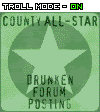
WHAT: The Long Winter WWII Airsoft Simulation
WHEN: 19-20 DEC 2009
WHERE: Home, WA
COST: $30
In early December 1944, Third Army's leading elements had pushed across the German border at several places along its front as the Germans withdrew into the Westwall. The 95th Division captured an intact bridge across the Saar River at Saarlautern in XX Corps' zone and encountered some of the stiffest resistance yet experienced, as the German troops fought to defend their own soil. The Americans discovered that the town of Saarlautern itself was part of the Westwall. Unlike the Maginot Line or the Metz fortifications, the Westwall did not consist of gigantic underground fortresses and heavy artillery emplacements. Instead, it was a belt of tank obstacles, barbed wire, pillboxes, and fortified buildings. Although the Germans considered the Westwall to be antiquated, shallow, and poorly equipped, it nonetheless constituted a formidable military obstacle. In Saarlautern the fighting was literally house-to-house and pillbox-to-pillbox. To facilitate the slow infantry advance, XX Corps' artillery fired in direct support of small units. The 8-inch and 240-mm pieces adjusted their fire on individual buildings on one side of the street, while American infantrymen on the opposite side of the street prepared to advance. The 90th Division forced a crossing of the Saar at Dillingen and encountered similar resistance. Casualties mounted as the Germans brought to bear the heaviest artillery fire that Third Army had yet experienced.
With toeholds established in the Westwall, LTG Patton initiated planning for a new offensive scheduled to jump off on 19 December. Veteran units such as the long-suffering 5th Division were pulled out of the action for reorganization and training. Patton received another corps headquarters, III Corps, and some fresh units, including 87th Division. Third Army's objectives for the December offensive were the same as they had been in August--bridgeheads across the Rhine in the vicinity of Mannheim and Mainz.
Preparations for the attack were well under way when, on 16 December, Third Army received fragmentary indications of trouble in First Army's sector to the north. It rapidly became apparent that a full-scale German counteroffensive was under way in the Ardennes. Patton quickly canceled the December offensive and implemented a contingency plan drawn up some days previously. The XX Corps abandoned its dearly bought bridgeheads over the Saar and assumed defensive positions on the west bank. On 20 December, XII Corps and III Corps, which had supervised the retraining of infantry fillers, shuffled divisions and turned north to strike the flank of the German penetration in the Ardennes. Third Army eventually assumed control of one other corps fighting in the Ardennes. The reorientation of a field army from east to north involved routing 12,000 vehicles along four roads, establishing a completely new set of supply points, and restructuring Third Army's entire signals network to support a new army headquarters in Luxembourg. Third Army troops entered the Battle of the Bulge on 22 December, and 4 days later LTC Creighton Abrams of Arracourt fame led his battalion of the 4th Armored Division to the relief of Bastogne.









